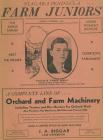1
Even though the climate and geography of Niagara, particularly Grimsby, is ideal for growing tender fruit, there have been many changes in technology and farming methods used to ensure that the fruit grown is of the highest quality and flavour. These changes involve the methods used in selecting, planting, growing, harvesting, storing, processing, packing, transporting and selling the tender fruit that grows in Grimsby and Niagara. There are a few that deserve special mention because of their importance or uniqueness.2
In 1880, the Department of Agriculture set aside twenty acres of land at the Agricultural College in Guelph as a fruit testing station. The area had a poor climate for testing the fruits and the experiments were unsuccessful; consequently many small trial stations were set up across Ontario on productive farms. Local farmer Murray Pettit of Winona had one of these experimental farms. A Provincial Fruit Experiment Station opened at Jordan Harbour in 1895 when farmers asked the government for technical information on spraying and other problems.3
VINELAND EXPERIMENTAL RESEARCH STATIONThe Vineland Research Station was created through a gift by local philanthropist Moses F. Rittenhouse in 1906. When it first opened in 1911, it was originally named the Dominion Entomological Laboratory and its purpose was to study insects and other fruit pests in the Niagara Region. There was great interest and support for the research as these pests were a problem for most farmers.
Between 1913 and 1956 many hybrid plants were cultivated and during those years thirty-one new hybrid varieties were released to farmers. Any hybrid developed at the Vineland Experimental Station has a name which starts with 'V'. Some of the most popular hybrids include the Viking Raspberry of 1924, the Veteran Peach of 1928, the Vanessa Seedless Grape of 1983 and the Vibrant Plum of 2006.
As the station expanded over the years many services were provided to local growers including tree pruning, soil management, soil and leaf analysis and ornamental horticulture. Research into cold storage and processing was conducted. Grape and wine production became a focus with the increased significance of this emerging industry to the region. By 1956, it was estimated that the station had two hundred and seventeen acres of experimental grounds. Today, the Vineland Horticultural Experimental Station is associated with the faculty of Plants and Agriculture at the University of Guelph.
4
SPECIALIZED TOOLS AND MACHINERYIn the beginning simple hand tools were used for pruning, picking and cultivating. While these are still used today, beginning in the 19th century new equipment was developed to assist the farmer.
During the growing season farmers needed to follow a spray programme to keep pests and insects as well as diseases from damaging the crops. Dry dusters were used to spray crops. Local merchants carried the necessary equipment and materials in their stores.
5
Grape Stalk Cutters20th Century, Circa 1900
Grimsby, Ontario, Canada
 Credits:
Credits:Grimsby Museum Collection
6
Apple Packers Tools, Advertisement for E. S. and R. T. Johnson - Grocers and Hardware Merchants14 October 1914
Grimsby, Ontario, Canada
 Credits:
Credits:Grimsby Museum Collection
7
Niagara Peninsula Farm JuniorsSpring 1935
Grimsby, Ontario, Canada
 Credits:
Credits:Grimsby Museum Collection
8
THE GROUT AGRICULTURAL WORKSThe Grout Agricultural Works was established in 1856 in the Village of Grimsby by John H. Grout. This factory would soon be known all over Ontario for its high quality farm tools and other metal implements. It was located on the north-east corner of Mountain Street and Elm Street. The first items produced at the Grout Agricultural Works were farm cultivating equipment, but as the farming industry began to grow there was a need for other products, and many new items were introduced. These new products included hay and grain mowers, binders and reapers.
10
Home of John H. Grout19th Century, Circa 1855
Mountain Street, Grimsby, Ontario, Canada
 Credits:
Credits:Grimsby Museum Collection
11
Letterhead of the John H. Grout and Co.19th Century, Circa 1890
Grout Agricultural Works, Grimsby, Ontario, Canada
 Credits:
Credits:Grimsby Museum Collection
12
Grout Agricultural Works Catalogue19th Century, Circa 1888
Grout Agricultural Works, Grimsby, Ontario, Canada
 Credits:
Credits:Grimsby Museum Collection
13
Demonstration of the Grout Binder19th Century, Circa 1890
Book Farm, Grimsby, Ontario, Canada
 Credits:
Credits:Grimsby Museum Collection
14
Catalogue Description of the Grout Binder19th Century, Circa 1888
Grout Agricultural Works, Grimsby, Ontario, Canada
 Credits:
Credits:Grimsby Museum Collection
